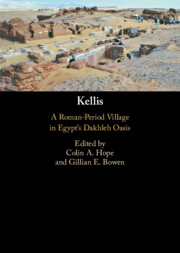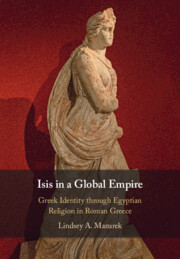Refine search
Actions for selected content:
23990 results in Ancient history
1 - Masters and Slaves in Early Christian Discourse
- from Part I - Moral and Symbolic Values of Slavery
-
-
- Book:
- Slavery in the Late Antique World, 150 – 700 CE
- Published online:
- 27 January 2022
- Print publication:
- 17 February 2022, pp 15-42
-
- Chapter
- Export citation
5 - Slavery in Euphemia and the Goth
- from Part II - Slavery, Cultural Discourses, and Identity
-
-
- Book:
- Slavery in the Late Antique World, 150 – 700 CE
- Published online:
- 27 January 2022
- Print publication:
- 17 February 2022, pp 107-128
-
- Chapter
- Export citation
6 - What Was Jewish about Jewish Slavery in Late Antiquity?
- from Part II - Slavery, Cultural Discourses, and Identity
-
-
- Book:
- Slavery in the Late Antique World, 150 – 700 CE
- Published online:
- 27 January 2022
- Print publication:
- 17 February 2022, pp 129-148
-
- Chapter
- Export citation
3 - (Il)Legal Freedom: Christ as Liberator from Satanic Debt Bondage in Greek Homilies and Hymns of Late Antiquity
- from Part I - Moral and Symbolic Values of Slavery
-
-
- Book:
- Slavery in the Late Antique World, 150 – 700 CE
- Published online:
- 27 January 2022
- Print publication:
- 17 February 2022, pp 66-86
-
- Chapter
- Export citation
2 - Slavery and Religion in Late Antiquity
- from Part I - Moral and Symbolic Values of Slavery
-
-
- Book:
- Slavery in the Late Antique World, 150 – 700 CE
- Published online:
- 27 January 2022
- Print publication:
- 17 February 2022, pp 43-65
-
- Chapter
- Export citation
Tables
-
- Book:
- Slavery in the Late Antique World, 150 – 700 CE
- Published online:
- 27 January 2022
- Print publication:
- 17 February 2022, pp viii-viii
-
- Chapter
- Export citation
Preface
-
- Book:
- Slavery in the Late Antique World, 150 – 700 CE
- Published online:
- 27 January 2022
- Print publication:
- 17 February 2022, pp xiii-xiv
-
- Chapter
- Export citation
Part III - Slavery, Social History, and the Papyrological and Epigraphical Sources
-
- Book:
- Slavery in the Late Antique World, 150 – 700 CE
- Published online:
- 27 January 2022
- Print publication:
- 17 February 2022, pp 189-248
-
- Chapter
- Export citation
Contributors
-
- Book:
- Slavery in the Late Antique World, 150 – 700 CE
- Published online:
- 27 January 2022
- Print publication:
- 17 February 2022, pp ix-xii
-
- Chapter
- Export citation
Part I - Moral and Symbolic Values of Slavery
-
- Book:
- Slavery in the Late Antique World, 150 – 700 CE
- Published online:
- 27 January 2022
- Print publication:
- 17 February 2022, pp 13-104
-
- Chapter
- Export citation
8 - Rural Slavery in Late Roman Gaul: Literary Genres, Theoretical Frames, and Narratives
- from Part II - Slavery, Cultural Discourses, and Identity
-
-
- Book:
- Slavery in the Late Antique World, 150 – 700 CE
- Published online:
- 27 January 2022
- Print publication:
- 17 February 2022, pp 170-188
-
- Chapter
- Export citation
Contents
-
- Book:
- Slavery in the Late Antique World, 150 – 700 CE
- Published online:
- 27 January 2022
- Print publication:
- 17 February 2022, pp v-vi
-
- Chapter
- Export citation

Kellis
- A Roman-Period Village in Egypt's Dakhleh Oasis
-
- Published online:
- 16 February 2022
- Print publication:
- 13 January 2022

Isis in a Global Empire
- Greek Identity through Egyptian Religion in Roman Greece
-
- Published online:
- 06 February 2022
- Print publication:
- 24 February 2022
2 - Alexander and Alexandria in Life and Legend
-
-
- Book:
- A History of Alexander the Great in World Culture
- Published online:
- 13 January 2022
- Print publication:
- 03 February 2022, pp 14-41
-
- Chapter
- Export citation
Abbreviations
-
- Book:
- A History of Alexander the Great in World Culture
- Published online:
- 13 January 2022
- Print publication:
- 03 February 2022, pp xv-xvi
-
- Chapter
- Export citation
Contents
-
- Book:
- A History of Alexander the Great in World Culture
- Published online:
- 13 January 2022
- Print publication:
- 03 February 2022, pp v-vi
-
- Chapter
- Export citation
Index
-
- Book:
- A History of Alexander the Great in World Culture
- Published online:
- 13 January 2022
- Print publication:
- 03 February 2022, pp 448-454
-
- Chapter
- Export citation
5 - Christianising Alexander Traditions in Late Antiquity
-
-
- Book:
- A History of Alexander the Great in World Culture
- Published online:
- 13 January 2022
- Print publication:
- 03 February 2022, pp 86-108
-
- Chapter
- Export citation
9 - The Slavic Alexander
-
-
- Book:
- A History of Alexander the Great in World Culture
- Published online:
- 13 January 2022
- Print publication:
- 03 February 2022, pp 197-215
-
- Chapter
- Export citation
